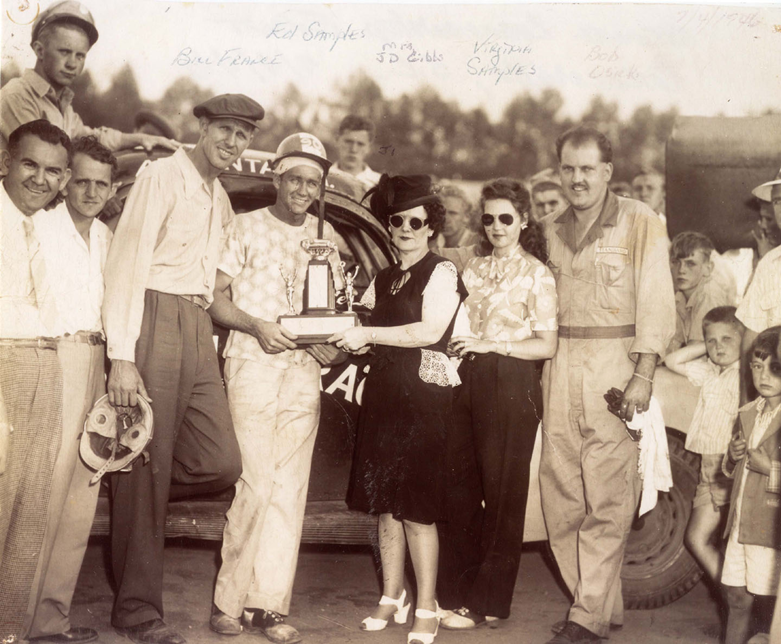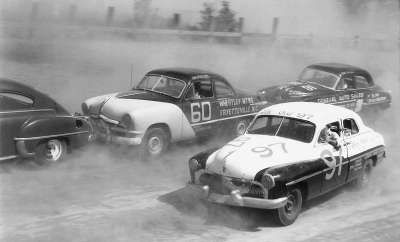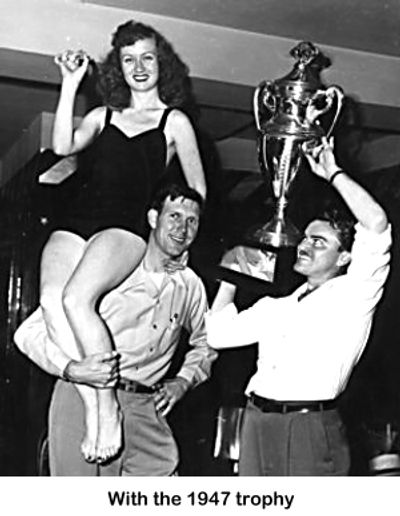I’ve been catching up on some reading, particularly a book I should have read years ago (it was published in 2010), “Real NASCAR – White Lightning, Red Clay and Big Bill France,” by Daniel S. Pierce. Along with “Driving with the Devil – Southern Moonshine, Detroit Wheels and the Birth of NASCAR,” by Neal Thompson, it’s a good way to get past the fluff that passes for racing history these days and learn how stock car racing and NASCAR got started.
“Real NASCAR” covers the period that ends with the beginning of Winston Cup – NASCAR’s “modern era” – in 1972. I want to write here about some of NASCAR’s darkest days in 1957 and see what they tell us about the challenges the sport faces today and how its leaders are addressing them.

A very young and very dapper Bill France (to the winner's left) in victory lane of one of his early promotion efforts.Bill France (the elder) and others (the ones you never hear about in NASCAR’s official histories) founded the association in December of 1947 and began holding races in ’48, primarily for “modified” cars (stock cars beefed up to go fast and hold up to the beating of a rough dirt track). The Cup Series’ predecessor, Strictly Stock, began in 1949, and it took a while for that series to establish Alpha-male status, but by the mid-‘50s, it was there.

Then the big factories got into racing (makes like Hudson and Studebaker had done so earlier, but their much lower car sales and budgets limited their impact), and the rocket ship NASCAR blasted off. For a couple of years, drivers and mechanics who might earlier have slept in their trucks and eaten beans out of a can and hot sausages from a jar in the country store were sleeping in nice hotels and eating/drinking like it was a dream.

In the early days, Grand National cars looked like showroom vehicles with numbers painted on the doors, but by the time the factories became involved, cars - and the garages for them - started looking a lot nicer.Turns out, it was. A huge pileup in the 1955 Daytona sportsman race resulted in one death, then popular driver Bill Vukovich died during the Indy 500, and then 80 people died at Le Mans when a car went into the crowd. It didn’t help that young Hollywood star James Dean also died in a car crash, although not at a race. It took some time for the changing public opinion to hit home in Detroit (AAA got the message earlier and had ended its involvement with sanctioning races in 1955), but in 1957, the factories pulled out.
It got worse. Popular driver Bobby Myers was killed during the 1957 Southern 500, and three even higher-visibility drivers – Tim Flock, Fonty Flock and Herb Thomas – announced their retirements.
Was NASCAR itself about to become the next crash victim? Not if Bill France could help it.
France had tried like the devil to make NASCAR a national sport, but he also knew that its core constituency was the working class men and families of Piedmont North and South Carolina, and he retrenched to that group.
Look at these stats:
In 1955, NASCAR ran 45 races, 21 of them in the Carolinas and 24 in 12 other states.
In 1956, it ran 56 races, 25 in the Carolinas and 31 in 15 other states.
By 1959, the 44-race schedule had 28 events in the Carolinas and 16 in 7 other states.
In 1962, not a single race was held outside the South. If racing needed to be a Southern sport to survive, that was Big Bill’s plan.

When the world looked like it was collapsing on NASCAR, Bill France retreated to the comfort of his core fans in the Piedmont Southeast. Note the nice crowd at Richmond in 1959.And it stayed that way until Detroit began to slip back into the game, first surreptitiously (funneling money through car dealers) and then openly. Also, superspeedways in Daytona, Atlanta and Charlotte joined Darlington to raise the sport’s visibility. Slowly, the good times returned, and then Winston joined the party, and you know the rest.
Because NASCAR was a smaller organization in the ‘50s, its very existence was probably more at risk than it has been over the past decade. But the bigger difference may be that Bill France was pretty much a one-man band running the show, and he could move it however he chose to meet a challenge. In 1957, at least in some ways, he was willing to see it get smaller in order to return to its larger size later. The much bigger NASCAR of today doesn’t run that way.
I wouldn’t be surprised if there are more vice presidents at NASCAR today than there were full-time employees in ’57, so many more people are affected by a get-smaller plan, and they’ll do just about anything to avoid that scenario.
I wonder, too, about backgrounds. Nearly everybody in Bill France’s NASCAR had an automotive background, which isn’t the case these days.
Another thing: Big Bill could move quickly to change. With multi-year contracts, corporate interests, and the dreaded (by this writer) charter system of car ownership, that’s a dream today.
The biggest point here, though, is that Bill France responded to a crisis situation by retreating to his core fan base. NASCAR has returned more race dates to the South this year, and it certainly made an effort to re-engage its core supporters, many of whom have grown disenchanted over the last 10-12 years, but it is taking a more long-range view, recognizing that there aren’t enough of us core folks to keep things going as they are now. With the mill workers, farm workers and working class gear-heads in general largely gone, they need a new core. The problem is, they still don’t know what it will take to attract and keep that core once they figure out who it is.
Maybe they need even more than Big Bill France these days.

One more thing. Bill France would do ANYTHING he could to help sell the show. Think any of the NASCAR suits would pose for something like this today?


Frank, this is wonderful. I like all the history and I really like the pictures. Your knowledge and research gives us great reading about how it was back then or BITD. Keeps me smiling knowing that I have more to look forward to. Thanks!
Thanks, Vivian. I’ve got a couple of other ideas to work on, so I think I’ll stick around.
NASCAR’s problem is that their core fans are either dead or so old that by the time they find the TV remote the race is already over. You can’t change the demographics .
Hey, I know where that remote is. I just can’t remember how to use it.
Mr. Buhrman,
I will say that with much of this article, you hit the nail squarly on the head. I am a prime example of why NASCAR may not survive and it is their fault! I’m one of those old, hardcore, diehard, stock car racing fans. I started following NASCAR in 1958. I became an avid fan. eating sleeping and breathing stock car racing in the 60s and70s. By 1985 or so, NASCAR started it’s radical departure away from stock car racing that has not only continued but has accelerated, to this day. In doing so, they have made it increasingly clear that they have no use for us, the diehard, grassroot, lifelong stock car racing fans, that they used, to get to the top, the carelessly discarded! As a “traditional” stock car racing fan, i have NO USE for road-racing or for all this high-tech indy/f-1/sport car crap! Stock car racing is not about all of that. With this new road-racing car and the drastic increase in the number of those kind of races on the schedule, two things are crystal clear — stock car racing is dead, at the end of this season and that there is nothing for the very few of us traditional stock car racing fans, that NASCAR had not already driven away, to remain. The handwriting is on the wall, more ovals will be replaced by these road and street-racing courses, so as that within 5 to 7 years, it will be either an exclusive road-racing series or a road-racing series with a very few “token” oval races added on. At the end of this season, i end my more than 60 years of being a fan. Though many of us are older, there are not as many of us that are dead, as some are trying to indicate that there are. There are still a whole lot us out here, enough that could make a difference. We have no problem finding the remote to the tv, we are not senile or too slow to turn on the races. The fact is, NASCAR in their zeal and desire to kill stock car racing and rid itself of us, has taken everything t5hat we loved about the sport away from us and left us with NOTHING! We didn’t leave NASCAR, NASCAR left us! They don’t want us, so we are gone, forever!
Best regards,
Lee (a soon to be former NASCAR fan)
Hi Lee, I am sorry you feel you have to leave NASCAR. Today, there were two great races at Bristol on the dirt. Yep, a few mistakes by NASCAR, but overall, it was very good racing and a lot of fun to watch.
Thank you for reading and commenting.
You’re welcomed. I recorded the Cup race and watched it on Tuesday. All I can say is that they botched it up as well. I attended several dirt track races, back in the pre-“modern” era, Grand National Division, including the last one run, in 1970, that Richard Petty won. The conduct of the race was totally different, as NASCAR is now using open-wheel dirt racinig format, rather than the way the ran back in the day. Plus, add to the fact, this race should have been at Eldora, Knoxville (IA) DuQuin or other proven dirt tracks, rather than converting Bristol. Also, I still get the feeling of NASCAR “influncing” this race, unlike in the old days. In closing, I will just say, in a recent internet conversation with a “new” NASCAR fan, I was rather rudly told, that to “get over it, this isn’t your father’s NASCAR”. This neophyte NASCAR fan likely has zero knowledge of anything NASCAR, before the current crop of young drivers, such as Christopher Bell, Kyle Larson, etc.. I have news for him and the rest of these Jonny come lately new fans, my NASCAR is the same as my father’s NASCAR! The ONLY thing the he got right is that is not my NASCAR! NASCAR, themselves, have seen to that. As I said earlier, I didn’t leave NASCAR, NASCAR left me and they have made it plainly obvious that they don’t want me, or other old breed stock car fans around.
Lee
Hi Lee! Thanks for stopping by and commenting here! I want you to stick around to tell us about Racing history and tell the stories from those days. Even if neither you nor me fits the NASCAR targeted demographic profile.